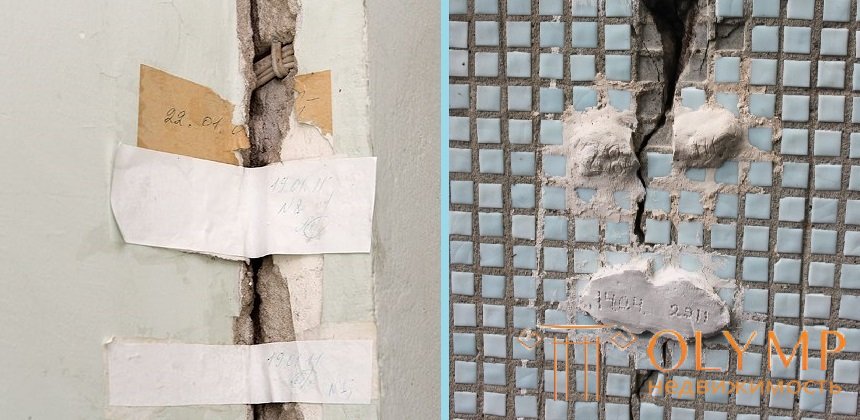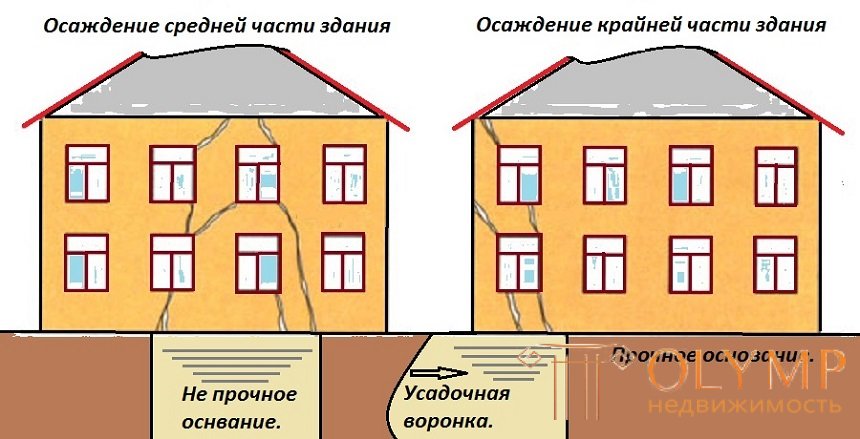
Cracks in the walls, to our great regret, are not uncommon, their presence is clearly observed on high-rise buildings, as well as on the walls of household structures and private residential buildings.
Specialized utilities deal with the defects of the walls of high-rise buildings, as this is a responsible and rather expensive event. Consider the causes of cracks in homes and buildings of the private, low-rise sector.
With high probability it can be argued that there are no houses without cracks. After all, cracks are formed not only from defects and defects during construction, but also from the natural precipitation of the structure, and even from its aging.
The main and most common cause of cracking on the walls of low-rise buildings is the result of uneven precipitation or destruction of the foundation . This happens for a number of rather different reasons, which we will discuss below.
Shallow (insufficient) depth of foundation: it is quite common in old buildings, it can lead to mobility of the soil under the foundation due to heaving or other reasons. 
Exceeding the design load on the ground: this usually occurs when you want to save money by making the foundation too narrow on movable soil.
When pouring the foundation, poor-quality building materials are used: poor quality concrete or gravel that is not suitable for strength or resistance to aggressive media. The brand of concrete used for the manufacture of such structures should not be less than M 200.
All the above reasons can be attributed to the violation of technology during the construction of the foundation. But there are other reasons that can not always be considered:
Violation of integrity or lack of a blind area around the house, can also cause cracks in the walls of the house. In this case, non-monolithic or non-reinforced foundations that are more prone to uneven shrinkage suffer more.
Not the last role is played by the quality of the building material of the walls themselves, namely, its behavior under the influence of external factors and loads: swelling, shrinkage, as well as vibration, which can activate the occurrence of cracks. These factors can be: the sun, rain, wind, and even the proximity of busy traffic.
As a rule, most cracks, whether external or internal flaws
do not carry danger. Even in rather old houses, whose age has exceeded 50 or even 100 years, fresh cracks can appear.
The reason for these processes may be - changes in the structure of the soil (due to increased humidity), construction work carried out in the vicinity, or, as already mentioned, heavy traffic.
Similarly, in new buildings: the appearance of cracks in the walls is not such a rarity. Usually small cracks in the plaster or lining of the building appear in the first years of operation. These processes are associated with the natural shrinkage of the structure and lasts, can from 3 to 5 years.
Such cracks are usually "calm", that is, they remain in the state in which they were found, and you can just hide them cosmetically.
Of course, we must not forget the fact that cracks in the walls can be the result of quite serious problems : defects in construction or weakening of the bearing elements. The latter occurs for various reasons, it may be, not professional redevelopment or restructuring of the building, and perhaps the banal leaching of soil.
If a vertical crack that grows in length and width appeared on the foundation, plinth and wall, then everything is very serious, and simple cosmetic measures are not enough. As a matter of concern, suddenly badly closing windows and doors, a noticeable skew of the porch, and, in general, a curvature, and cracking of horizontal lines on the facade should be a cause for concern.
To determine the level of danger, it is necessary to find out how the crack behaves. It is quite simple to make such observations: a control strip of paper is stuck on the crack, but for more convenient observation it is better to apply a plaster mark.
Such a palm-wide mark, of heavily diluted gypsum, is applied to the crack and is observed for 3 to 4 weeks. If the crack breaks the mark and continues to grow further, then cardinal measures should be taken to prevent further damage.

Check marks from paper and plaster.
If you are not a specialist in construction, or are afraid to do something wrong, then the easiest way is to contact a qualified specialist who can analyze the causes and suggest options for eliminating them. But in some cases, it can be done independently.
Most of the serious problems arise from several factors, which most likely were not taken into account when building the foundation. Defects of this kind are expressed in the draft of a part of the building, which leads to cracks in the external or internal walls.
Most often, these are errors at the design stage during surveys - no external factors are taken into account.
Seasonal changes in the ground: provoke subsidence, leaching and frost swelling, characteristic of a number of soils (clay, loam, dusty soil), as well as changes in the level of groundwater.
An incorrect or incomplete assessment of the strength of the foundation: a problem arises when in different parts of the trench or foundation pit there are no buried pits (ditches), as well as rigid supports (natural or artificial boulders, concrete wells, etc.).
Violations in the operation of the building: usually occur when flooding, rather than rarely, and leaching of the base of the foundation with household or atmospheric water (a rush of sewage, water mains or destruction of the blind area).


Also such structural flaws as the omission of reinforcing inserts in the intersections of the walls, the lack of cross-links, insufficient rigidity of the longitudinal wall, and in some cases, a large gap from the rafters may cause the wall to deviate from the vertical, and accordingly cause cracks in the walls.
Что бы оставить комментарий войдите
Комментарии (0)